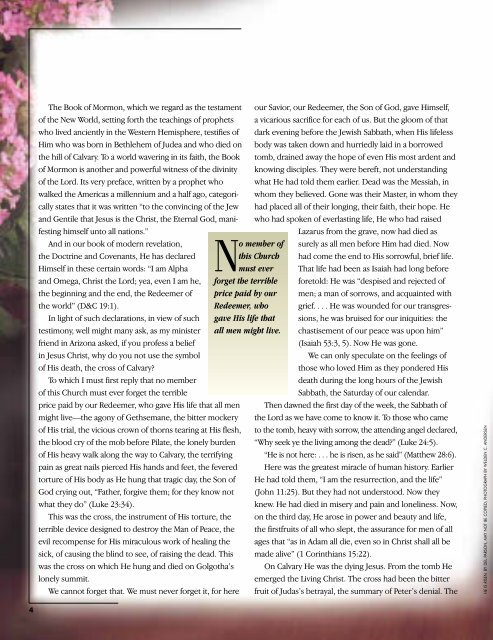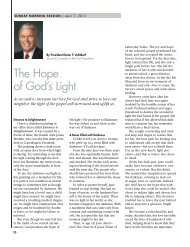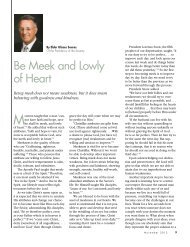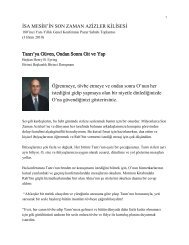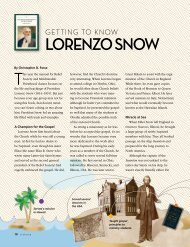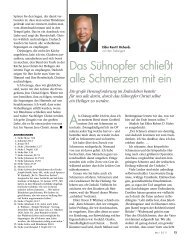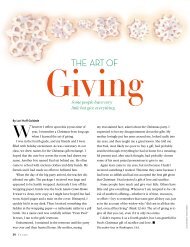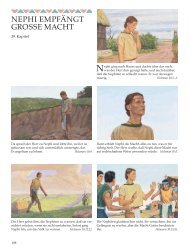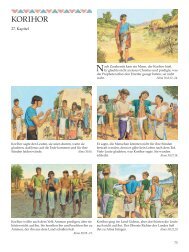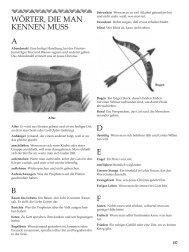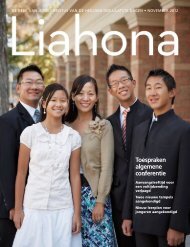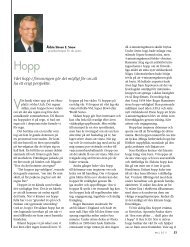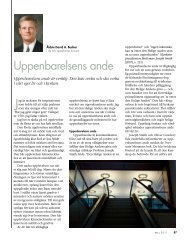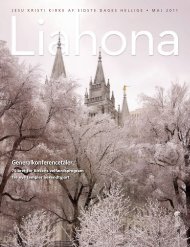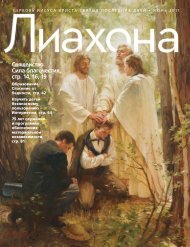April 2005 Ensign - The Church of Jesus Christ of Latter-day Saints
April 2005 Ensign - The Church of Jesus Christ of Latter-day Saints
April 2005 Ensign - The Church of Jesus Christ of Latter-day Saints
Create successful ePaper yourself
Turn your PDF publications into a flip-book with our unique Google optimized e-Paper software.
4<br />
<strong>The</strong> Book <strong>of</strong> Mormon, which we regard as the testament<br />
<strong>of</strong> the New World, setting forth the teachings <strong>of</strong> prophets<br />
who lived anciently in the Western Hemisphere, testifies <strong>of</strong><br />
Him who was born in Bethlehem <strong>of</strong> Judea and who died on<br />
the hill <strong>of</strong> Calvary. To a world wavering in its faith, the Book<br />
<strong>of</strong> Mormon is another and powerful witness <strong>of</strong> the divinity<br />
<strong>of</strong> the Lord. Its very preface, written by a prophet who<br />
walked the Americas a millennium and a half ago, categorically<br />
states that it was written “to the convincing <strong>of</strong> the Jew<br />
and Gentile that <strong>Jesus</strong> is the <strong>Christ</strong>, the Eternal God, manifesting<br />
himself unto all nations.”<br />
And in our book <strong>of</strong> modern revelation,<br />
the Doctrine and Covenants, He has declared<br />
Himself in these certain words: “I am Alpha<br />
and Omega, <strong>Christ</strong> the Lord; yea, even I am he,<br />
the beginning and the end, the Redeemer <strong>of</strong><br />
the world” (D&C 19:1).<br />
In light <strong>of</strong> such declarations, in view <strong>of</strong> such<br />
testimony, well might many ask, as my minister<br />
friend in Arizona asked, if you pr<strong>of</strong>ess a belief<br />
in <strong>Jesus</strong> <strong>Christ</strong>, why do you not use the symbol<br />
<strong>of</strong> His death, the cross <strong>of</strong> Calvary?<br />
To which I must first reply that no member<br />
<strong>of</strong> this <strong>Church</strong> must ever forget the terrible<br />
price paid by our Redeemer, who gave His life that all men<br />
might live—the agony <strong>of</strong> Gethsemane, the bitter mockery<br />
<strong>of</strong> His trial, the vicious crown <strong>of</strong> thorns tearing at His flesh,<br />
the blood cry <strong>of</strong> the mob before Pilate, the lonely burden<br />
<strong>of</strong> His heavy walk along the way to Calvary, the terrifying<br />
pain as great nails pierced His hands and feet, the fevered<br />
torture <strong>of</strong> His body as He hung that tragic <strong>day</strong>, the Son <strong>of</strong><br />
God crying out, “Father, forgive them; for they know not<br />
what they do” (Luke 23:34).<br />
This was the cross, the instrument <strong>of</strong> His torture, the<br />
terrible device designed to destroy the Man <strong>of</strong> Peace, the<br />
evil recompense for His miraculous work <strong>of</strong> healing the<br />
sick, <strong>of</strong> causing the blind to see, <strong>of</strong> raising the dead. This<br />
was the cross on which He hung and died on Golgotha’s<br />
lonely summit.<br />
We cannot forget that. We must never forget it, for here<br />
No member <strong>of</strong><br />
this <strong>Church</strong><br />
must ever<br />
forget the terrible<br />
price paid by our<br />
Redeemer, who<br />
gave His life that<br />
all men might live.<br />
our Savior, our Redeemer, the Son <strong>of</strong> God, gave Himself,<br />
a vicarious sacrifice for each <strong>of</strong> us. But the gloom <strong>of</strong> that<br />
dark evening before the Jewish Sabbath, when His lifeless<br />
body was taken down and hurriedly laid in a borrowed<br />
tomb, drained away the hope <strong>of</strong> even His most ardent and<br />
knowing disciples. <strong>The</strong>y were bereft, not understanding<br />
what He had told them earlier. Dead was the Messiah, in<br />
whom they believed. Gone was their Master, in whom they<br />
had placed all <strong>of</strong> their longing, their faith, their hope. He<br />
who had spoken <strong>of</strong> everlasting life, He who had raised<br />
Lazarus from the grave, now had died as<br />
surely as all men before Him had died. Now<br />
had come the end to His sorrowful, brief life.<br />
That life had been as Isaiah had long before<br />
foretold: He was “despised and rejected <strong>of</strong><br />
men; a man <strong>of</strong> sorrows, and acquainted with<br />
grief. . . . He was wounded for our transgressions,<br />
he was bruised for our iniquities: the<br />
chastisement <strong>of</strong> our peace was upon him”<br />
(Isaiah 53:3, 5). Now He was gone.<br />
We can only speculate on the feelings <strong>of</strong><br />
those who loved Him as they pondered His<br />
death during the long hours <strong>of</strong> the Jewish<br />
Sabbath, the Satur<strong>day</strong> <strong>of</strong> our calendar.<br />
<strong>The</strong>n dawned the first <strong>day</strong> <strong>of</strong> the week, the Sabbath <strong>of</strong><br />
the Lord as we have come to know it. To those who came<br />
to the tomb, heavy with sorrow, the attending angel declared,<br />
“Why seek ye the living among the dead?” (Luke 24:5).<br />
“He is not here: . . . he is risen, as he said” (Matthew 28:6).<br />
Here was the greatest miracle <strong>of</strong> human history. Earlier<br />
He had told them, “I am the resurrection, and the life”<br />
(John 11:25). But they had not understood. Now they<br />
knew. He had died in misery and pain and loneliness. Now,<br />
on the third <strong>day</strong>, He arose in power and beauty and life,<br />
the firstfruits <strong>of</strong> all who slept, the assurance for men <strong>of</strong> all<br />
ages that “as in Adam all die, even so in <strong>Christ</strong> shall all be<br />
made alive” (1 Corinthians 15:22).<br />
On Calvary He was the dying <strong>Jesus</strong>. From the tomb He<br />
emerged the Living <strong>Christ</strong>. <strong>The</strong> cross had been the bitter<br />
fruit <strong>of</strong> Judas’s betrayal, the summary <strong>of</strong> Peter’s denial. <strong>The</strong><br />
HE IS RISEN, BY DEL PARSON, MAY NOT BE COPIED; PHOTOGRAPH BY WELDEN C. ANDERSEN


